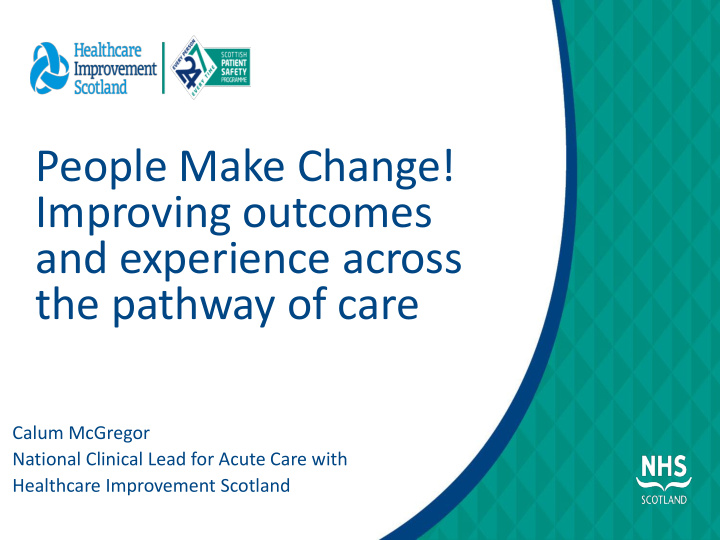



People Make Change! Improving outcomes and experience across the pathway of care Calum McGregor National Clinical Lead for Acute Care with Healthcare Improvement Scotland
Glasgow Transport Museum
People Make Change – Learn and design better systems 1. Share SPSP approach to whole system improvement 2. Examples from the deteriorating patient workstream – applying QI methods and developing culture of improvement 3. Focus on patient journey and co-production
SEPSIS IN SCOTLAND 2012 • 25% of patients with severe sepsis receiving IV antibiotics within an hour • http://www.stag.scot.nhs.uk/SEPSIS/ Main.html
BARRIERS to quality across the pathway of care • Poorly designed systems • A culture not receptive to quality improvement • Unwanted variation • Silo working with poor communciation • Patient/carer voice not being heard
Poorly Designed Systems
“The Aggregation of Marginal Gains”
Poorly Designed Systems / Opportunities to Improve • Antibiotics not in department • Patient going to X-ray prior to antibiotics and fluids • Triage system not robust enough to prioritise sick patients • Nursing staff not informed of STAT antibiotic prescription • MEWS added incorrectly • Not applicable section on form • Medical Students…. • Lack of awareness • WE’RE TOO BUSY!
AIM and STRATEGY • To reduce mortality and harm for people in acute hospitals by reliable recognition and response to acutely unwell patients • Outcome Measures: • HSMR • Sepsis Mortality Rate • Cardiac Arrest Rate
METHOD for improvement Deming WE 1994 ‘The New Economics: For Industry, Government, Education’ MIT Press: Massachusetts p41
National Improvement
National Improvement
NEWS 2 – Lessons from Highland
Where to focus? – Local Improvement
Understand Own Systems • The measurement and monitoring of safety. Vincent et al. 2013
Make it easy for staff to do the right thing
Reduce Unwanted Variation
Progress: Local Process and Outcome Sepsis Mortality Rate
Pride in Work
Resilience Engineering • “Learning from what went well” • Safety 1 v Safety 2
Save of the Month! • MDT Review • Establish what went well • Aim to increase reliability of desirable “thing” • Apply model for improvement to test plan (PDSA)
Give power to patients / Carers
Shared Decision Making Anticipatory care planning • 29% of inpatients in last year of life Clark D et al. Imminence of death among hospital inpatients. Palliative Medicine.2014, 28 (6). 474-479.
Treatment Escalation Planning
Cede Power to Patients Help patients make informed decisions
Cede Power to Patients • Patient Activated Consultant • Nobody Phoned! Response • Consultant Response to Activation by Patient (CRAP) • ? Failed test • "Felt safe." "Wasn't worried and could tell staff were busy." "No need." "Staff explained there would be a wait" • Flatten hierarchy and show willing
Focus on Patient Journey
Primary Care / Scottish Ambulance Service • Pre-Alerting in NHS Lanarkshire, GG and C, Highland and Grampian Martin Carberry, and John Harden BMJ Qual Improv Report 2016;5:u212670.w5049
Improve Patient Journey
Outcome Measures - Sepsis 30 Day Mortality (inpatients with Sepsis) 35.0 Mean 1 = 24.8 30.0 Mean 2 = 20.3 Reduction from Percentage mortality Baseline = 21% 25.0 20.0 15.0 10.0 This is a 21% reduction 5.0 0.0 Jan-11 Apr-11 Jul-11 Oct-11 Jan-12 Apr-12 Jul-12 Oct-12 Jan-13 Apr-13 Jul-13 Oct-13 Jan-14 Apr-14 Jul-14 Oct-14 Jan-15 Apr-15 Jul-15 Oct-15 Jan-16 Apr-16 Jul-16 Oct-16 Jan-17 Apr-17 Jul-17 Data source: ISD Scotland
Cardiac Arrest rate in 17 Scottish Hospitals 3.0 Median 2 = 1.76 Current Median 1.42 Reduction from Reduction from 2.5 Baseline = 11% Baseline = 28% Baseline Median 1.98 rate per 1000 discharges 2.0 1.5 This is a 28% reduction, 1.0 which means that there are Signal of approximately 25 fewer 0.5 further cardiac arrests per month reduction 0.0 Feb-13 Apr-13 Jun-13 Aug-13 Oct-13 Dec-13 Feb-14 Apr-14 Jun-14 Aug-14 Oct-14 Dec-14 Feb-15 Apr-15 Jun-15 Aug-15 Oct-15 Dec-15 Feb-16 Apr-16 Jun-16 Aug-16 Oct-16 Dec-16 Feb-17 Apr-17 Jun-17 Aug-17 Oct-17 Dec-17 Feb-18 Apr-18 Jun-18 Aug-18 Data source: SPSP returns
HSMR for deaths within 30 days of hospital admission Current Median 0.87 1.2 Median 2 = 0.94 Reduction from Baseline Median 1.00 Reduction from Hospital Standardised Mortality Ratio Baseline = 13% Baseline = 6% 1.0 0.8 This is a 13% 0.6 reduction 0.4 0.2 0.0 Mar-11 Jun-11 Sep-11 Dec-11 Mar-12 Jun-12 Sep-12 Dec-12 Mar-13 Jun-13 Sep-13 Dec-13 Mar-14 Jun-14 Sep-14 Dec-14 Mar-15 Jun-15 Sep-15 Dec-15 Mar-16 Jun-16 Sep-16 Dec-16 Mar-17 Jun-17 Sep-17 Dec-17 Mar-18 Jun-18 Sep 18p Data source: ISD Scotland
Summary Can improve - requires whole system and local level QI input Make it easier to do the right thing for patients Learn and design better systems
Recommend
More recommend